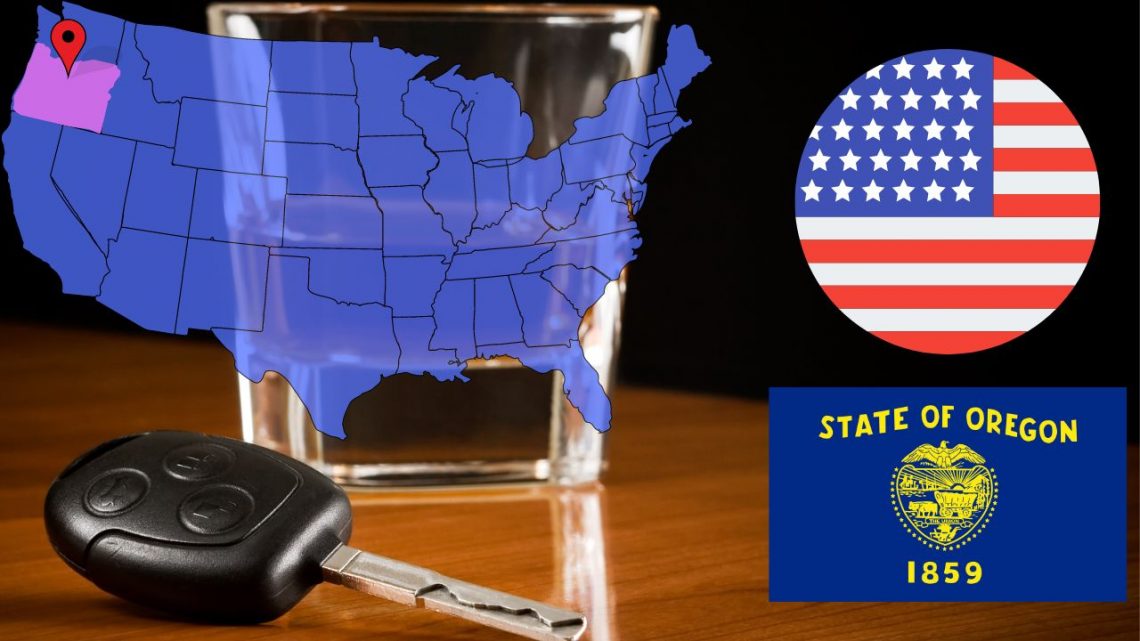In Oregon, operating a vehicle with a blood alcohol content (BAC) that exceeds 0.08% (equivalent to 80 milligrams of alcohol per 100 milliliters of blood) is illegal. Driving with a BAC at or above this level may lead to a DUII (Driving While Under the Influence of Intoxicants) arrest.
Please keep in mind that this article aims to spread awareness of Oregon’s drunk driving laws. This website does not endorse drinking and driving under any circumstances.
What is the Legal Alcohol Limit for Driving in Oregon?
In Oregon, the legal alcohol limits for driving are determined by the type of driver’s license and the driver’s age to ensure safety on the roads and reduce the risk of accidents related to impaired driving. Here’s a detailed breakdown of the legal BAC (blood alcohol content) limits for different categories of drivers:
- Regular Drivers: The legal limit is 0.08% BAC. This means that for most drivers operating personal vehicles, having a blood alcohol concentration of 80 milligrams of alcohol per 100 milliliters of blood is the maximum allowed by law.
- Commercial Drivers: For individuals holding a commercial driver’s license, the legal limit is more stringent at 0.04% BAC. This lower threshold reflects the increased responsibility commercial drivers have due to the potential for larger vehicles to cause more significant harm in the event of an accident.
- Minors (Under 21): Oregon enforces a zero-tolerance policy for underage drivers. It is illegal for minors to operate a vehicle with any detectable amount of alcohol in their system. This law underscores the importance of absolute sobriety for young drivers to protect themselves and others on the road.
Drink and Drive Penalties and Punishments in Oregon
In Oregon, the consequences of driving under the influence of intoxicants (DUII) are severe, with the law strictly enforcing penalties to deter such behavior and promote road safety. The legal framework surrounding DUII includes fines, mandatory installations, and potential jail time depending on the severity and recurrence of the offense. Here’s an overview of the penalties and punishments as outlined in the state’s legislation:
- Driving Under the Influence of Intoxicants (DUII): It’s illegal to operate a vehicle with a BAC of 0.08% or higher, or while under the influence of intoxicants. This applies if the BAC is measured within two hours of driving without consuming alcohol in the intervening time.
- Penalties:
- A DUII offense can range from a Class A misdemeanor to a Class C felony, depending on prior convictions and the specific circumstances of the offense.
- Fines vary based on the offense number and the presence of aggravating factors, such as having a BAC of 0.15% or more, or carrying a passenger under 18 years old who is at least three years younger than the driver.
- Minimum fines range from $500 to $2,000, with the potential for a maximum fine of $10,000 under certain conditions.
- Repeat offenders face increased fines, mandatory ignition interlock device installation, and possible jail time, with a mandatory minimum term of incarceration for felony DUII convictions.
- Felony DUII: A DUII is classified as a Class C felony if the offender has at least two prior convictions for similar offenses within the past ten years. Conviction results in a mandatory minimum incarceration period of 90 days, without reduction.
It’s crucial for drivers in Oregon to understand these laws and the serious consequences of violating them. These penalties are designed to prevent impaired driving and ensure the safety of all road users. Given the complexity of DUII regulations and the potential for changes, individuals are encouraged to regularly consult the official state website for the most current information regarding DUII laws and penalties in Oregon. This proactive approach can help drivers stay informed about their legal obligations and the potential consequences of driving under the influence of intoxicants.
How Can I Calculate If My Alcohol Blood Limit Is Legal in Oregon?
In Oregon, police determine a driver’s blood alcohol content (BAC) level primarily through the use of breathalyzer tests during traffic stops or DUI checkpoints. These devices are designed to measure the concentration of alcohol in one’s breath, providing an immediate estimate of blood alcohol levels. Understanding your BAC before driving is crucial to ensure you’re within the legal limit and to avoid the severe penalties associated with DUII offenses. Here are two recommended methods to check your BAC:
1. Use a High-Quality Alcohol Breathalyzer
Investing in a reliable alcohol breathalyzer is one of the most effective ways to estimate your BAC. The BACtrack S80, available in Oregon, is a top choice for its professional-grade accuracy, DOT & NHTSA approval, and FDA 510(k) clearance. Its precision makes it a valuable tool for anyone looking to make informed decisions about their ability to drive safely. Keeping a device like the BACtrack S80 in your vehicle is especially advised, as it can help you recognize when you may be impaired and prevent DUII incidents.
2. Utilize My Online BAC Calculator
With the collaboration of fellow phlebologists and web developers, I have developed an online BAC calculator. This tool allows you to input factors such as the amount and type of alcohol consumed, your weight, and the time elapsed since drinking to estimate your BAC. While this method provides a convenient and quick way to understand your intoxication level, it’s important to remember that it offers an approximation rather than an exact measurement.
Both of these methods serve as useful tools to help gauge whether your BAC is likely above or below Oregon’s legal limit of 0.08%. However, it’s essential to keep in mind that individual factors can influence BAC and its effects, meaning these tools cannot guarantee absolute accuracy. They are best used as guidelines to help you avoid making the decision to drive when there’s a risk of being over the legal limit.
Driving with a BAC at or above 0.08% in Oregon is illegal and can result in significant legal consequences. By proactively checking your BAC and making informed decisions, you can contribute to safer roads and avoid the penalties associated with DUII offenses.
Ways to Avoid Driving with a High BAC in Oregon

Driving with a high blood alcohol concentration (BAC) is not only illegal in Oregon but also extremely dangerous. It puts not just the driver, but also passengers and other road users at risk. Fortunately, there are several reliable alternatives to driving under the influence:
1. Utilize Rideshare Apps or Local Taxi Services
Rideshare applications like Uber and Lyft offer a convenient and accessible way to get home safely without the risk of DUII (Driving Under the Influence of Intoxicants). These apps provide a quick solution to find a ride at almost any hour, ensuring you can avoid driving with a high BAC.
For those who prefer traditional taxi services, local companies in Oregon are also a great choice. In Portland, consider using Metro Cab & Metro Car for a reliable ride. In Salem, Amanda’s Taxi is known for dependable service. These local taxis can be a safer alternative, ensuring you reach your destination without the need to drive.
2. Opt for Designated Driver Services
If you find yourself in a situation where you’ve driven to a location and consumed alcohol, and are now unable to safely drive back, designated driver services are an excellent option. These services can send a driver to drive you and your car back home safely. In Portland, PDX Designated Drivers provides such services, ensuring both you and your vehicle get back without the risks associated with impaired driving. In Salem, Taxi Salem | Life Taxis LLC | Great Service offers similar services, catering to those who need a safe way home without leaving their car behind.
To find a designated driver service in your area, a simple Google search with “designated driver service” along with your city’s name should provide you with various options. This proactive step can significantly reduce the risk of DUII charges and contribute to safer roadways for everyone.
By choosing these alternatives over driving with a high BAC, you’re not only adhering to Oregon’s laws but also prioritizing the safety of yourself and others. Always plan ahead and consider these safe transportation options to ensure a responsible and safe return home.
Sticking to DUI Laws in Oregon: Sad Statistics
In 2020, Oregon experienced 508 road fatalities, with 38% involving drivers with a BAC of 0.08% or higher. It’s crucial to avoid driving under the influence. If you’ve consumed alcohol, opt for a designated driver, Uber, or taxi instead.
Oregon’s DUI laws aim to curb impaired driving. Before getting behind the wheel, check your BAC with a reliable breathalyzer to ensure compliance with state limits.
For accurate and current DUI laws and regulations in Oregon, visit the state’s official website. Remember, even minimal alcohol consumption can impair driving abilities. Prioritize safety by considering alternative transportation options and ensure your BAC is below the legal limit.







